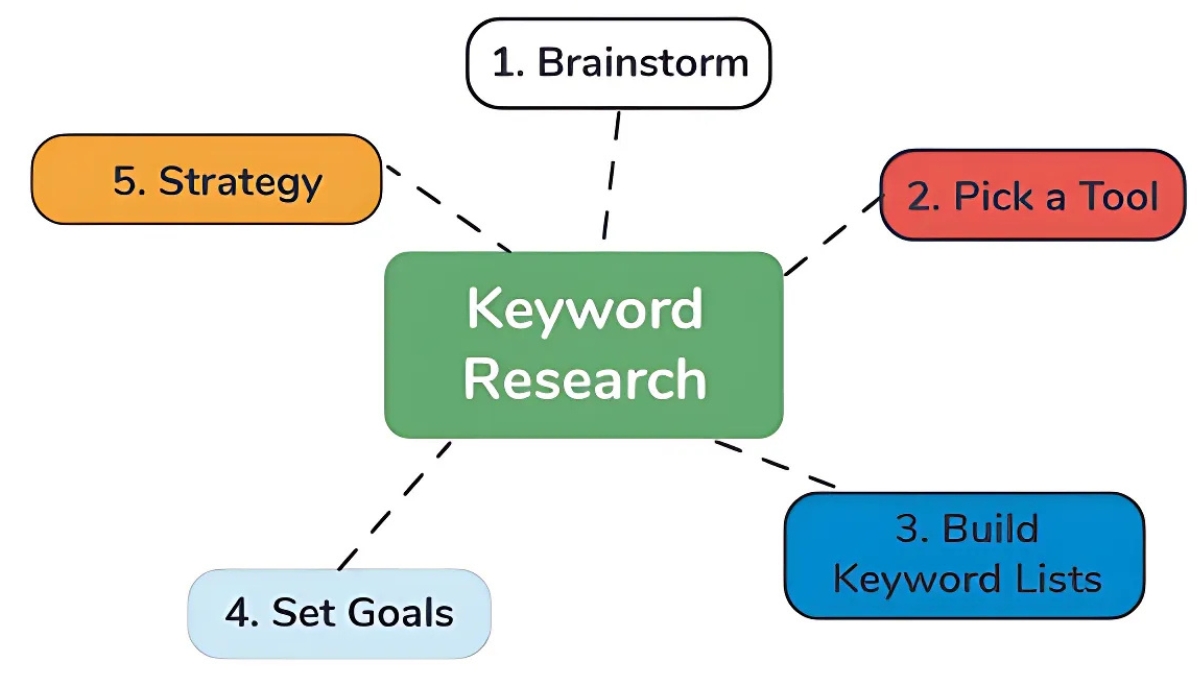
How to Do Keyword Research in 2025: A Step-by-Step Guide for Beginners
Did you know that 68% of online experiences begin with a search engine? Yet many content creators still struggle with finding the right keywords to target! I’ve spent years helping businesses improve their SEO, and I can tell you that effective keyword research is the foundation of any successful content strategy. In this guide, I’ll walk you through everything you need to know about conducting keyword research that drives real results.
Understanding Keyword Research Fundamentals
Think of keyword research like being a detective who’s trying to understand what your audience really wants. It’s the process of discovering the actual words and phrases people type into search engines when they’re looking for information, products, or services. I learned this lesson the hard way when I spent six months targeting the keyword “best coffee maker” only to realize I should have been focusing on more specific terms like “best drip coffee maker under $100” that actually matched what my readers were searching for.
Let’s break down the different types of keywords, because this is where things get interesting. You’ve got your short-tail keywords (also called head terms), which are usually just 1-2 words like “coffee maker” or “SEO tips.” These typically have high search volume but are super competitive. I remember competing for these terms early in my career – it was like trying to win an Olympic race without any training!
Long-tail keywords, on the other hand, are more like complete phrases or questions. Think “how to clean a coffee maker with vinegar” or “best SEO tips for small business websites.” These usually have lower search volume, but here’s the kicker – they often convert better because they’re more specific to what people actually want. Plus, they’re usually easier to rank for. When I switched to focusing on long-tail keywords, my traffic actually became more valuable because visitors were finding exactly what they were looking for.

Now let’s talk about the metrics that really matter. Search volume isn’t everything – I learned that lesson when I ranked #1 for a high-volume keyword that brought tons of traffic but zero conversions! You need to look at:
- Search Volume: How many people search for this term monthly
- Keyword Difficulty: How hard it’ll be to rank for this term
- Search Intent: What people actually want when they search for this term
Search intent is probably the most crucial factor that took me years to really understand. There are four main types:
- Informational (“how to do keyword research”)
- Navigational (“google keyword planner login”)
- Commercial (“best keyword research tools”)
- Transactional (“buy ahrefs subscription”)
Here’s a pro tip that changed my whole approach: Look at the current top-ranking pages for your target keyword. Are they blog posts? Product pages? Tools? This tells you exactly what type of content Google thinks matches the search intent.
The impact on your content strategy can’t be overstated. Good keyword research helps you create content that actually serves a purpose. I used to just write whatever I thought was interesting, but now I let keyword research guide my content calendar. It’s like having a direct line to what your audience wants to read about.
Remember this: keyword research isn’t just about finding words to target – it’s about understanding your audience’s needs and creating content that genuinely helps them. When you nail this fundamental concept, everything else in SEO becomes much clearer. Trust me, I wish someone had explained it to me this way when I was starting out!
Enhance your digital marketing expertise with SEO and Social Media Marketing EBook Sets! These comprehensive guides cover the latest techniques for improving search engine rankings and creating high-performing social media campaigns. Learn to drive organic traffic, boost engagement, and convert followers into customers. Perfect for entrepreneurs, marketers, and anyone aiming to excel in the digital space. Start achieving your marketing goals today!
Essential Keyword Research Tools and Resources
Let’s start with the free tools because, honestly, that’s where everyone should begin. Google Keyword Planner is like your starter Pokemon – it might not be the most powerful, but it gets the job done. The best part? It pulls data directly from Google, so you know it’s legitimate. I spent my first year using just this tool, and while it has its limitations (like combining similar keywords into volume ranges), it’s still incredibly valuable for understanding search demand.
AnswerThePublic is another free tool that completely changed how I think about content creation. It shows you the actual questions people are asking about your topic! I remember using it for a client’s gardening website and discovering dozens of questions about tomato plants that we’d never thought to address. Pro tip: download the CSV file of all questions before they limit your daily searches – learned that one the hard way!
Now, let’s talk about premium tools. I resisted paying for tools for the longest time (who hasn’t?), but eventually, I bit the bullet and tried SEMrush. It was like upgrading from a bicycle to a sports car! The difference in data quality and features was mind-blowing. SEMrush starts at $119.95 per month, and while that seemed expensive at first, it paid for itself within two months by helping me find better keyword opportunities.
Ahrefs is another powerhouse tool that I now use daily. Their Keywords Explorer tool is probably the most accurate for keyword difficulty scores – something I discovered after comparing rankings success rates across different tools. The basic plan starts at $99 per month, but here’s a money-saving tip: start with their $7 seven-day trial to export as much data as you can and plan your content strategy in advance.
Moz Pro is often overlooked, but their keyword difficulty score was surprisingly accurate for local SEO projects. I used it extensively when working with a chain of local restaurants. Their plans start at $99 per month, and they offer really good educational resources along with the tool.

Here’s a practical comparison I wish someone had shown me earlier:
Google Keyword Planner (Free):
- Great for search volume trends
- Perfect for Google Ads planning
- Limited keyword difficulty data
- Combines similar keywords
AnswerThePublic (Free):
- Excellent for finding questions
- Great for content ideation
- Limited searches per day
- No volume data
SEMrush ($119.95+):
- Comprehensive competitor analysis
- Accurate position tracking
- Good content optimization tools
- More expensive but worth it for agencies
Ahrefs ($99+):
- Best keyword difficulty scores
- Excellent backlink data
- Great UI/UX
- Limited features in basic plan
One thing I learned the hard way: don’t jump straight into premium tools just because everyone recommends them. Start with the free tools and master them first. I wasted three months of subscription fees because I wasn’t ready to fully utilize the premium features!
For beginners, I recommend this approach: Start with Google Keyword Planner and AnswerThePublic. Once you’re consistently creating content and need more data, try a month of SEMrush or Ahrefs. Use that month to export as much data as possible and plan out your next few months of content. Then decide if the ongoing cost is worth it for your business.
Remember, the most expensive tool isn’t always the best for your specific needs. I’ve seen bloggers do amazing things with just free tools, and I’ve seen others waste money on premium subscriptions they barely use. The right tool is the one that fits your workflow and budget – and sometimes that’s just Google Keyword Planner and a good spreadsheet!
Step-by-Step Keyword Research Process
Starting with seed keywords is like planting a garden – you need good seeds to grow good results! I always begin by writing down the main topics related to my business or website. For example, when I was working on a fitness website, I didn’t just write down “workout” – I brainstormed different angles like “home workouts,” “strength training,” and “weight loss exercises.” Pro tip: use your customer service emails or frequently asked questions as inspiration for seed keywords. They’re gold mines of real user language!
Here’s my exact process for analyzing search intent (this totally changed my success rate). First, I Google my target keyword and look at the top 10 results. Are they mostly how-to guides? Product pages? News articles? This tells you exactly what Google thinks users want to see. I learned this lesson the hard way when I created a lengthy how-to guide for a keyword where users were clearly looking to buy products – total waste of time!
When it comes to evaluating competition, don’t just look at the domain authority numbers – that’s a beginner mistake I made for months. Instead, check:
- How many of the top 10 results are from major brands?
- What’s the content quality like?
- How many backlinks do the top pages have?
- When was the content last updated?
I use a simple spreadsheet to track everything, which I’ve refined over time. Here’s the exact structure I use:
Column A: Seed Keyword Column B: Related Keywords Column C: Monthly Search Volume Column D: Keyword Difficulty (1-100) Column E: Search Intent Column F: Current Ranking (if any) Column G: Priority Score (1-5) Column H: Notes
For prioritizing keywords, I developed this formula that works really well: Priority = (Monthly Search Volume × Conversion Potential) ÷ Keyword Difficulty. The conversion potential is my subjective 1-5 rating based on how likely the keyword is to drive valuable traffic.

One thing that really improved my results was creating separate tabs for different search intents. I have one tab for informational keywords, another for commercial keywords, and a third for transactional keywords. This makes it much easier to plan content that matches user needs.
Here’s a time-saving tip I discovered: when you find a good keyword, plug it into “People Also Ask” sections in Google. I’ve found some amazing low-competition keywords this way that my tools didn’t even show me! Last month, I found a keyword with 2,400 monthly searches and relatively low competition just by clicking through PAA boxes.
Organization is crucial – I learned this after losing hours of work to disorganized spreadsheets. Now I color-code my keywords based on priority: green for immediate opportunities, yellow for medium-term goals, and red for long-term aspirations. This visual system helps me quickly decide what content to create next.
The most important lesson I’ve learned? Don’t get paralyzed by analysis. I used to spend weeks analyzing keywords before creating any content. Now I follow the 80/20 rule – once I find a keyword that meets my basic criteria (decent volume, manageable competition, clear intent), I start creating content. You can always optimize later!
Remember to revisit your keyword research regularly. Markets change, search trends shift, and new opportunities emerge. I block out the first Monday of every month to review and update my keyword research. This habit has helped me stay ahead of trends and consistently find new opportunities before they become too competitive.
The beauty of this process is that it scales. Whether you’re working on a personal blog or managing a large website, these same steps will help you find and prioritize the right keywords for your goals. Just remember: good keyword research isn’t about finding the highest search volumes – it’s about finding the right opportunities for your specific situation.
Advanced Keyword Research Strategies
Looking back at my years of SEO work, the transition from basic to advanced keyword research was a real game-changer. I remember the exact moment it clicked – I was analyzing a competitor’s website when I spotted a massive content gap they’d completely missed. That discovery led to one of our most successful pieces of content ever!
Let me share how I hunt for keyword gaps in competitor content. First, I take my top 3-4 competitors and export all their ranking keywords. Then comes the fun part – I use a VLOOKUP formula in Excel to identify keywords they rank for that I don’t. But here’s the clever trick I discovered: pay special attention to keywords where they rank poorly (positions 8-20). These are often opportunities where you can create better content and outrank them quickly.
Google Search Console has been an absolute goldmine for me. I was honestly sleeping on this tool for years! Here’s my favorite strategy: look for keywords where you’re ranking on page two (positions 11-20) with decent impressions. These are your “low-hanging fruit” opportunities. I once improved a page’s ranking from position 14 to position 2 just by better aligning the content with search intent – the traffic increase was insane!
SERP analysis is something I do religiously now, and it’s way more than just looking at the top 10 results. Here’s my exact process:
- Check the SERP features (featured snippets, PAA boxes, etc.)
- Analyze the content format (listicles, how-tos, guides)
- Look for patterns in titles and headings
- Note the content length and depth of each ranking page
I learned about topic clustering the hard way – after spending months creating random content with no real structure. Now I use what I call the “hub and spoke” model. For example, if I’m targeting “organic gardening,” I’ll create a comprehensive pillar page about organic gardening basics, then create detailed cluster content about soil preparation, natural pest control, companion planting, etc. Each piece links back to the pillar content, creating a strong topical authority signal.
Speaking of semantic search, this is where things get really interesting. I use a technique I developed called “semantic layering.” Instead of just focusing on one main keyword, I identify 3-4 layers of semantically related terms:
Layer 1: Main keyword
Layer 2: Direct synonyms and variations
Layer 3: Related concepts and subtopics
Layer 4: Industry-specific terminolog

Here’s a pro tip about scaling keyword research that saved me hours: create process templates! I have templates for everything – competitor analysis spreadsheets, content briefs, even email outreach for building topical authority. The key is to make these templates flexible enough to work across different niches but specific enough to be actually useful.
One of my biggest breakthroughs came when I started using Python scripts to automate parts of my keyword research process. I’m not a programming expert, but I learned enough to create simple scripts that could clean up keyword exports and identify patterns in the data. This cut my research time in half!
The most valuable lesson I’ve learned about advanced keyword research? It’s not just about finding keywords – it’s about understanding the entire search landscape for your topic. I now spend as much time analyzing user intent patterns and content gaps as I do looking at traditional keyword metrics.
A word of caution though – don’t get caught up in advanced techniques before mastering the basics. I’ve seen people jump into complex topic clustering before they could even properly analyze search intent. Master the fundamentals first, then layer on these advanced strategies one at a time.
Remember to regularly audit your advanced keyword strategy. I set aside time every quarter to review our topic clusters, check for new semantic relationships, and update our templates based on what’s working best. This systematic approach has helped us consistently improve our search visibility across multiple sites and niches.
The beauty of advanced keyword research is that it helps you see the bigger picture. You’re not just finding keywords anymore – you’re uncovering content opportunities and building topical authority in your niche. That’s when SEO gets really exciting!
Common Keyword Research Mistakes to Avoid
You know what really keeps me up at night? Thinking about all the keyword research mistakes I made when I first started in SEO. Let me share some hard-learned lessons that cost me months of wasted effort – hopefully you can avoid these same pitfalls!
The biggest facepalm moment in my career was when I completely ignored search intent. I had this client who sold running shoes, and I pushed hard to rank for “marathon training” because it had awesome search volume. Guess what? We ranked well, but the traffic was worthless because people searching for training tips weren’t looking to buy shoes! Now I always check the top 10 results first to understand what users actually want.
Speaking of search volume – oh boy, was I obsessed with those numbers early on! I remember turning down a keyword with 300 monthly searches in favor of one with 2,500. Big mistake! The lower-volume keyword had way better conversion rates because it was more specific to our products. These days, I look at the whole picture: volume, competition, conversion potential, and even seasonality.
Local search was another blind spot for me. I was working with a small bakery, focusing on broad terms like “birthday cakes” and “wedding cakes,” completely missing out on “custom cakes near me” and “[city name] bakery.” The local terms had lower volume but brought in actual customers! Pro tip: use Google’s location selector in Keyword Planner to see accurate local search volumes.
Here’s a painful story about competitor analysis – or rather, my lack of it. I spent three months creating content around keywords that seemed perfect, only to discover that a major competitor had already covered these topics extensively with much more authority than we could match. Now I always check competitor content before committing to keywords. I use a simple spreadsheet to track:
- Who ranks for each keyword
- Their content quality
- Their domain authority
- Their backlink profile

Seasonal trends? Yeah, I learned about those the hard way too. I once planned a huge content push around “holiday gift guides” in November. Too late! The big sites had their content up by September and had already captured most of the rankings. These days, I keep a calendar of seasonal trends and plan content at least 3-4 months in advance.
One mistake that really makes me cringe was assuming that high keyword difficulty always meant “don’t try.” Sometimes it’s worth going after tough keywords if you can create significantly better content than what’s ranking. I discovered this when we outranked a major competitor for a difficult keyword simply because our content was more detailed and up-to-date.
Want to know my most embarrassing keyword research mistake? I used to create separate pages for every slight keyword variation: “how to bake cookies,” “how to make cookies,” “cookie baking guide.” Not only did this confuse our site structure, but it also diluted our ranking potential. Now I focus on comprehensive content that naturally includes relevant variations.
The truth is, good keyword research isn’t about finding perfect keywords – it’s about understanding your audience and creating content that serves their needs. I learned to stop chasing numbers and start focusing on value. When I made that mental shift, our content started performing much better in search results.
Remember this: every mistake is a learning opportunity. I keep a “lessons learned” document where I record my keyword research missteps and what I should have done differently. It’s helped me develop a much more effective research process over time.
If you take anything away from my mistakes, let it be this: always put user intent first, don’t get hypnotized by big search volumes, and remember that the best keyword opportunities often come from understanding your specific market niche. The rest will follow!
Turning Keyword Research into Action
Creating content briefs was a game-changer for me. I used to just hand writers a keyword and hope for the best – what a disaster that was! Now I create detailed briefs that include everything we learned from our keyword research. Here’s the exact template I use:
- Target keyword and related terms
- Search intent analysis (with screenshots of top-ranking pages)
- Required headings and topics to cover
- Word count range (based on SERP analysis)
- Types of images or media needed
- Key points from competitor content that we need to address
Content calendars were another revelation. I developed what I call the “90-day rolling calendar” system. Every month, I update the next three months of content, considering seasonal trends and business goals. The trick is to be flexible – I reserve about 20% of our content slots for trending topics or unexpected opportunities. When COVID hit, this flexibility saved us because we could quickly pivot our content strategy.
Let’s talk about monitoring performance because this is where I see so many people drop the ball. I created a simple tracking system that checks three key metrics:
- Ranking changes (weekly)
- Organic traffic (monthly)
- Conversion rates (monthly)
Pro tip: Set up Google Data Studio dashboards for automated reporting. It took me a while to figure this out, but now I save hours each month on reporting!
Updating existing content is like finding money in your old jeans – it’s the easiest win in SEO! I learned this after our traffic dropped 30% following a Google update. Now I have a systematic approach:
- Identify posts older than 6 months
- Check current rankings and traffic trends
- Analyze current top-ranking content for gaps
- Update statistics and examples
- Add new sections based on “People Also Ask” questions

Here’s a specific example: I had an article about home office setups that was ranking #6. After updating it with new product recommendations and adding a section about ergonomics (based on PAA questions), it jumped to #2 within three weeks. The traffic doubled!
Scaling your keyword strategy is tricky – believe me, I learned this the hard way when trying to manage content for multiple sites. The key is creating systems that can grow with you. I use a combination of tools:
- Trello for content workflow
- Google Sheets for keyword tracking
- Slack channels for team communication
- Templates for everything (seriously, everything!)
One of my favorite scaling tricks is what I call “content clusters on steroids.” Once you find a successful content format, create templates and processes to replicate it across different topics. For example, we had a successful “ultimate guide” format that we rolled out across 20 different topics, maintaining quality while scaling up production.
The biggest lesson I’ve learned? Don’t let perfect be the enemy of good. I used to spend weeks perfecting content briefs and calendars. Now I focus on getting content out the door and optimizing based on real data. It’s better to have 80% perfect content that’s published than 100% perfect content that never sees the light of day.
Remember, turning keyword research into action is an iterative process. Start small, measure what works, and gradually scale up your successful strategies. And don’t forget to celebrate the wins – even small ranking improvements mean you’re moving in the right direction!
Effective keyword research is an ongoing process that requires both art and science. By following this guide and consistently applying these strategies, you’ll be well-equipped to discover valuable keyword opportunities that drive targeted traffic to your site. Remember, the key is to focus on your audience’s needs while balancing search volume and competition. Ready to put these keyword research techniques into practice? Start with one of the free tools mentioned above and begin building your keyword foundation today!





